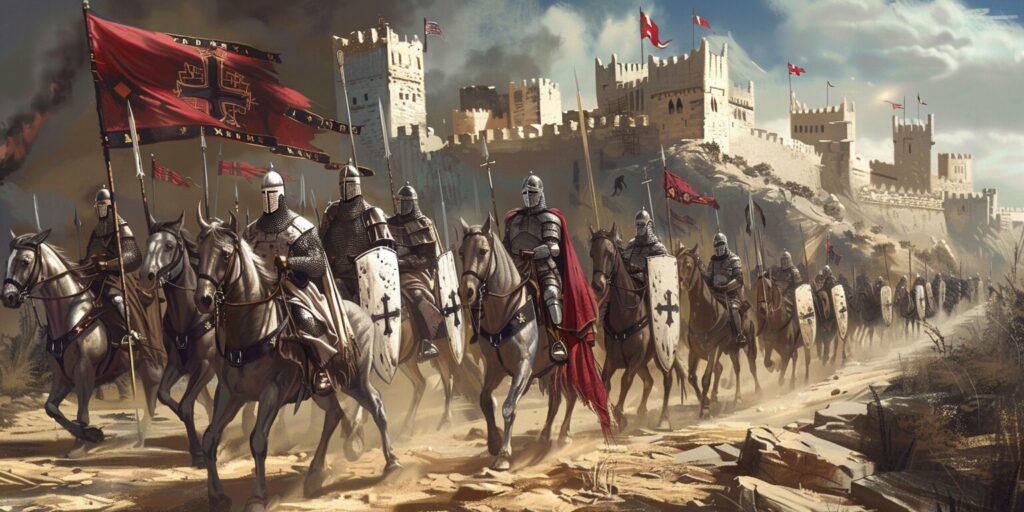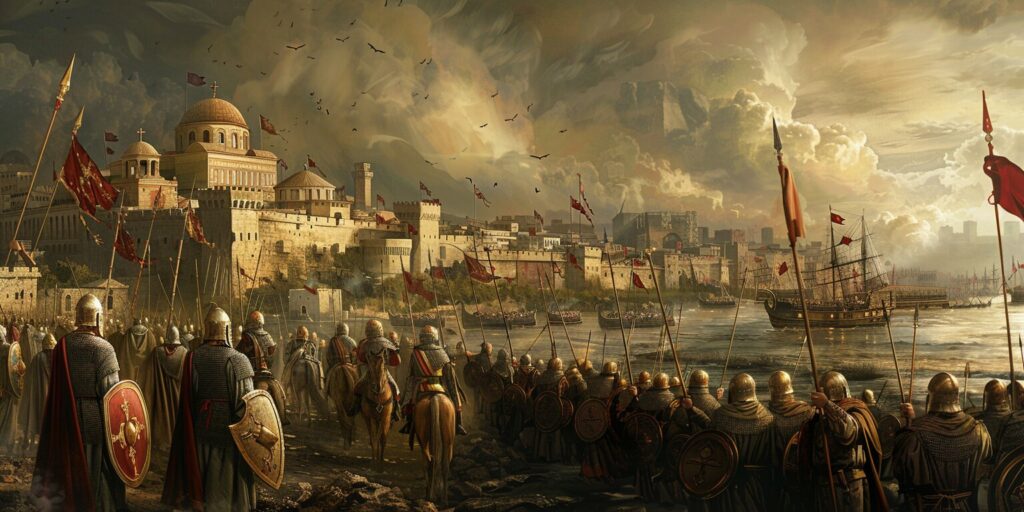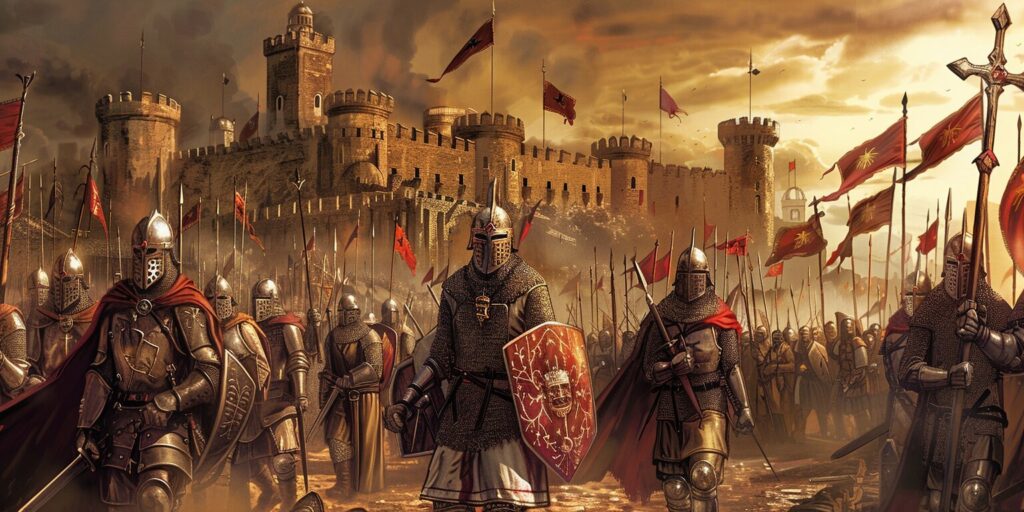Welcome to our comprehensive guide to the first Crusade timeline. In this article, we will delve into the key events, leaders, and pivotal moments that shaped this historic campaign. Join us as we explore the journey of European forces to the Holy Land and the battles fought along the way.
Background and Causes of the First Crusade
In the late 11th century, Europe bore witness to a momentous event that would reshape the course of history – the First Crusade. This military campaign, instigated by European Christian rulers, was motivated by a complex interplay of political, religious, and economic factors.
The events leading up to the First Crusade can be traced back to the reign of Byzantine emperor Alexios I Komnenos, who sought assistance from the West to combat the encroaching Seljuk Turks. This plea for help set in motion a chain of events that would ignite the fervor for crusading.
Europe was rife with political instability and power struggles among feudal lords at the time. The lure of a holy war in the East presented a unique opportunity for these leaders to assert their authority, create alliances, and divert attention from domestic issues.
Religion also played a crucial role in the call for Crusades. Pope Urban II, in his famous speech at the Council of Clermont in 1095, captured the imagination of the masses by appealing to their religious fervor. He issued a call to arms, preaching the liberation of the Holy Land from Muslim control and the redemption of sins through participation in the crusade.
Economically, the First Crusade offered the prospect of wealth and prestige to those who participated. The allure of plunder, trade opportunities, and potential territorial gains motivated European knights and soldiers to take up the cross.
These events and influences created a perfect storm, propelling the First Crusade. European leaders, knights, and commoners alike were swept up in the fervor and embarked on a journey that would have profound consequences for both the East and the West.
Causes of the First Crusade Summary:
- Political instability and power struggles among European feudal lords
- Appeal from Byzantine emperor Alexios I Komnenos for assistance against the Seljuk Turks
- Religious fervor and the call to liberate the Holy Land from Muslim control
- Economic motivations, including the prospect of wealth, trade opportunities, and territorial gains
| Factors | Explanation |
|---|---|
| Political | Europe experienced political instability and power struggles among feudal lords. |
| Religious | Pope Urban II issued a call to arms, appealing to the religious fervor of the masses. |
| Economic | The prospect of wealth, plunder, trade opportunities, and potential territorial gains motivated participants. |
Preparation and Organization
The first crusade required meticulous preparation and organization before embarking on the momentous journey to the Holy Land. Driven by their deep religious fervor, the Crusaders sought to reclaim Jerusalem from the hands of the Muslims. This section will delve into the significant steps taken to ensure the success of this historic expedition.

Recruitment of Participants
The first crusade attracted participants from all walks of life. Nobles, knights, and commoners alike were inspired by Pope Urban II’s call to arms, fueling the formation of a diverse and formidable force. The recruitment efforts spanned across Europe, with leaders such as Bohemond of Taranto, Godfrey of Bouillon, and Raymond IV of Toulouse rallying tens of thousands of crusaders to the cause.
Establishment of Armies
Once the participants were recruited, the establishment of armies became crucial. The first crusade witnessed the formation of multiple armies, each with its own leaders and goals. These armies were organized into contingents primarily based on geographical origins, with notable divisions such as the Northern French Army, the German Army, and the Lombard Army. Each contingent was assigned its own leader responsible for maintaining discipline and cohesion.
Logistics and Supplies
Undertaking such a massive expedition required meticulous logistics and supplies planning. The Crusaders faced the daunting task of ensuring they had sufficient provisions, weapons, and equipment for the long and arduous journey. Supply lines were established, and stockpiles of food, water, and ammunition were strategically positioned along the way to support the troops during their march through unfamiliar territories.
Financial Arrangements
Funding the first crusade was a major undertaking, as the costs associated with mobilizing and sustaining such a massive army were significant. Nobles and leaders often relied on their own resources, selling or mortgaging their lands and properties to finance their involvement. Additionally, the church played a crucial role in providing financial support, with donations and tithes collected from across Europe contributing to the cause.
The Journey to the Holy Land
When embarking on the first crusade, the crusader armies had a long and arduous journey ahead of them as they made their way to the Holy Land. Each army took different routes, facing various challenges along the way.
The main crusader armies started their journey from different parts of Europe, converging at Constantinople, where they received supplies and additional troops. From there, they set forth toward their ultimate destination, Jerusalem.
One key route the Crusaders took was through Anatolia (modern-day Turkey). Led by leaders such as Bohemond of Taranto and Godfrey of Bouillon, they faced numerous battles and encounters with local armies. This route allowed them to secure important cities such as Antioch and Ma’arrat al-Numan, marking significant milestones in their journey.
Another route followed by the Crusaders was through the Balkans and Greece. Led by leaders like Raymond IV of Toulouse and Stephen of Blois, they faced challenges such as difficult terrains and hostile encounters with local populations. However, they managed to advance through these regions, reaching Constantinople and joining the other armies.
As the Crusaders made their way toward the Holy Land, they encountered diverse landscapes, ranging from deserts to mountains. They relied on local knowledge and guides to navigate the unfamiliar territories along their journey.
Interactive Map: Explore the Routes of the Crusaders
Take a closer look at the routes taken by the Crusader armies during the First Crusade:
| Crusader Army | Route |
|---|---|
| Bohemond of Taranto | Through Anatolia |
| Godfrey of Bouillon | Through Anatolia |
| Raymond IV of Toulouse | Through the Balkans and Greece |
| Stephen of Blois | Through the Balkans and Greece |
As you can see from the interactive map and table, the first crusaders took multiple routes, adapting to the challenges they faced along the way. Their journeys were filled with obstacles, but their determination to reach the Holy Land remained unwavering.
Key Battles and Siege Warfare
In the tumultuous landscape of the First Crusade, key battles and intense instances of siege warfare played a pivotal role in shaping the outcome of this historic campaign. Let’s explore some of the significant events that took place during this tumultuous period.
The Siege of Nicaea
One of the early challenges faced by the Crusaders was the siege of Nicaea, a strategic city in Anatolia. Led by Emperor Alexios I Komnenos of the Byzantine Empire, the Crusader forces laid siege to Nicaea in 1097. After a grueling two-month siege, the city finally fell to the Crusaders, marking a crucial victory.

The Battle of Dorylaeum
In their journey towards Jerusalem, the Crusaders faced formidable opposition at the Battle of Dorylaeum in 1097. Led by leaders like Godfrey of Bouillon and Bohemond of Taranto, the Crusaders successfully repelled multiple attacks from the Seljuk Turks, securing a decisive victory.
The Siege of Jerusalem
The First Crusade’s climactic moment was the Jerusalem Siege in 1099. After a long and treacherous journey, the Crusaders arrived at the Holy City. They besieged Jerusalem for several weeks, facing fierce resistance from the Fatimid Caliphate. Eventually, in July 1099, the Crusaders breached the city walls and captured Jerusalem, establishing the Kingdom of Jerusalem.
These key battles and sieges, among others, demonstrate the immense trials and triumphs of the First Crusade. The bravery and endurance of the Crusader forces, strategic alliances, and military prowess led to their mission’s eventual success.
| Event | Date | Outcome |
|---|---|---|
| Siege of Nicaea | 1097 | Crusader victory, capture of Nicaea |
| Battle of Dorylaeum | 1097 | Crusader victory repelled the Seljuk Turks |
| Siege of Jerusalem | 1099 | Crusader victory, capture of Jerusalem |
Legacy of the First Crusade
The first crusade left a lasting legacy that shaped European society, the Kingdom of Jerusalem, and subsequent crusades for centuries to come. Let’s explore the enduring impact of this historic campaign.
The Influence on European Society
The First Crusade significantly impacted European society both during and after the expedition. The mass participation in the crusade led to a restructuring of feudal society, with many lesser lords and knights selling their lands to join the cause. This resulted in a redistribution of wealth and power among the European aristocracy, leading to changes in the social and political landscape.
Additionally, contact between Western Europeans and the Byzantine Empire during the Crusade facilitated cultural and intellectual exchanges. The Crusaders were exposed to the Byzantines’ rich knowledge and advanced technology, leading to an influx of new ideas and innovations in various fields, including architecture, medicine, and trade.
The Kingdom of Jerusalem
One of the most significant outcomes of the First Crusade was the establishment of the Kingdom of Jerusalem. After capturing Jerusalem in 1099, the Crusaders established a Christian state in the region, which lasted for nearly two centuries. The Kingdom of Jerusalem became a melting pot of cultures and religions, leading to the emergence of a unique society that integrated aspects of Western, Eastern, and Middle Eastern influences.
The Kingdom of Jerusalem also played a crucial role in stimulating trade and economic development in the region. The Crusaders established trading networks with Europe, promoting the flow of goods and ideas between East and West. Additionally, the wealth and resources brought to the region by the Crusaders led to the construction of magnificent castles, fortifications, and churches, leaving a lasting architectural legacy.
Subsequent Crusades
The first crusade set the stage for subsequent crusades that followed in the centuries to come. The initial success of the expedition and the establishment of the Kingdom of Jerusalem inspired further attempts to regain lost Christian territories in the Holy Land. These subsequent crusades, however, were not as successful as the first, with varying degrees of military and political achievements.
Despite their mixed outcomes, the subsequent crusades continued shaping Europe and the Middle East’s political, religious, and cultural landscape. The interactions between the Crusaders and local populations resulted in the exchange of knowledge, ideas, and technologies, contributing to the development of medieval European civilization.
| Legacy of the First Crusade | Description |
|---|---|
| Restructuring of feudal society | The first crusade led to a redistribution of wealth and power among the European aristocracy, which changed the social and political landscape. |
| Cultural and intellectual exchanges | The contact between Western Europeans and the Byzantine Empire during the Crusade facilitated knowledge and technology exchange, leading to advancements in various fields. |
| Establishment of the Kingdom of Jerusalem | The capture of Jerusalem led to the establishment of a Christian state in the region, stimulating trade and economic development and leaving a lasting architectural legacy. |
| Inspiration for subsequent crusades | The first crusade’s initial success inspired further attempts to regain lost Christian territories, shaping Europe and the Middle East’s political, religious, and cultural landscapes. |
Conclusion
In conclusion, the First Crusade is a testament to the power of faith, politics, and ambition in shaping history. Spanning from 1096 to 1099, this historic campaign witnessed the unfolding of significant events that left an indelible mark on European society and the Holy Land.
Thanks to the efforts of brave leaders and determined Crusaders, the First Crusade saw the capture of key cities such as Nicaea, Antioch, and Jerusalem. These victories secured territories for the Christian forces and established the Kingdom of Jerusalem, a lasting consequence of the Crusaders’ zeal and sacrifice.
However, the first crusade was not without its controversies and complexities. Alongside the achievements, there were instances of violence, bloodshed, and strained relations among the crusader factions. Nonetheless, its impact on European society, trade, and the subsequent crusades cannot be undermined, as it set the stage for centuries of conflict and religious fervor in the name of reclaiming the Holy Land.
By understanding the First Crusade timeline and context, we can better appreciate the individuals, events, and ideologies that shaped this extraordinary chapter in history. The First Crusade remains a topic of ongoing academic study, and its far-reaching consequences continue to influence our understanding of religion, politics, and cultural exchange in the medieval world.

